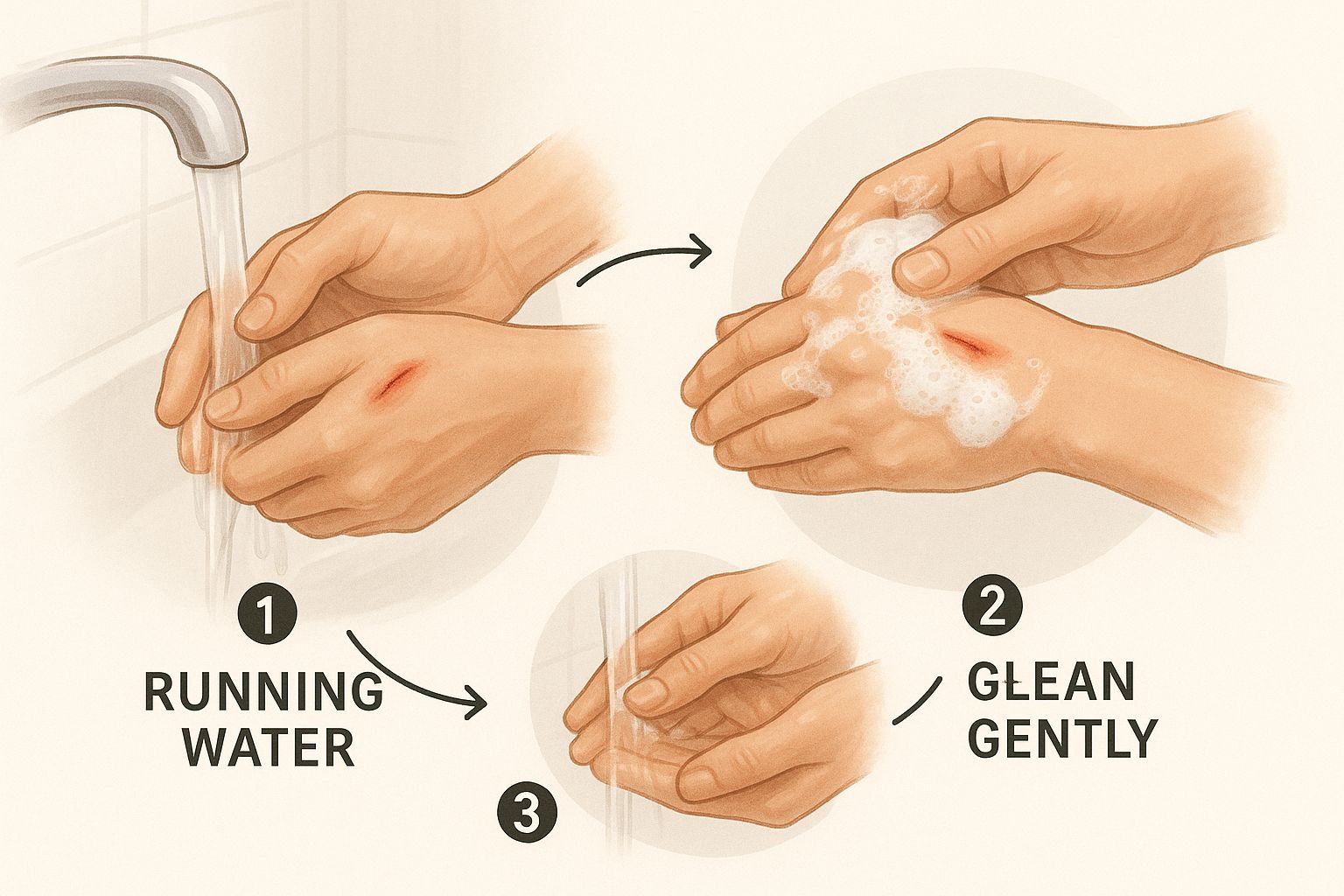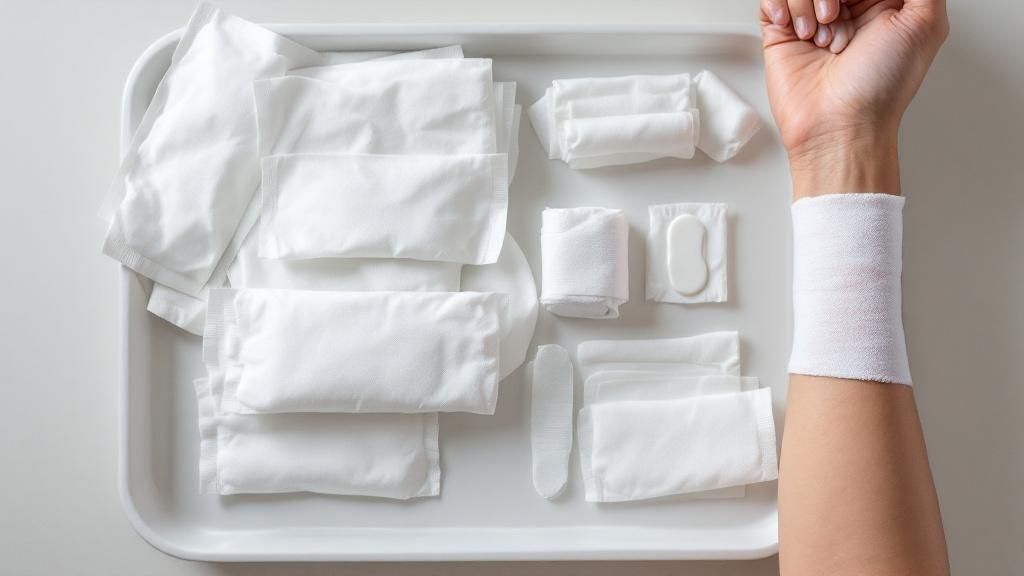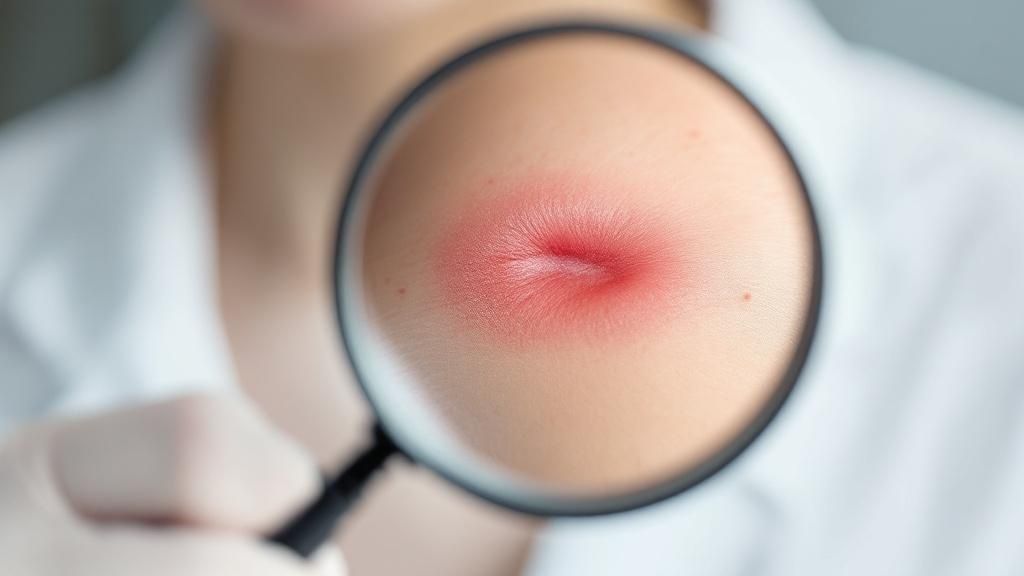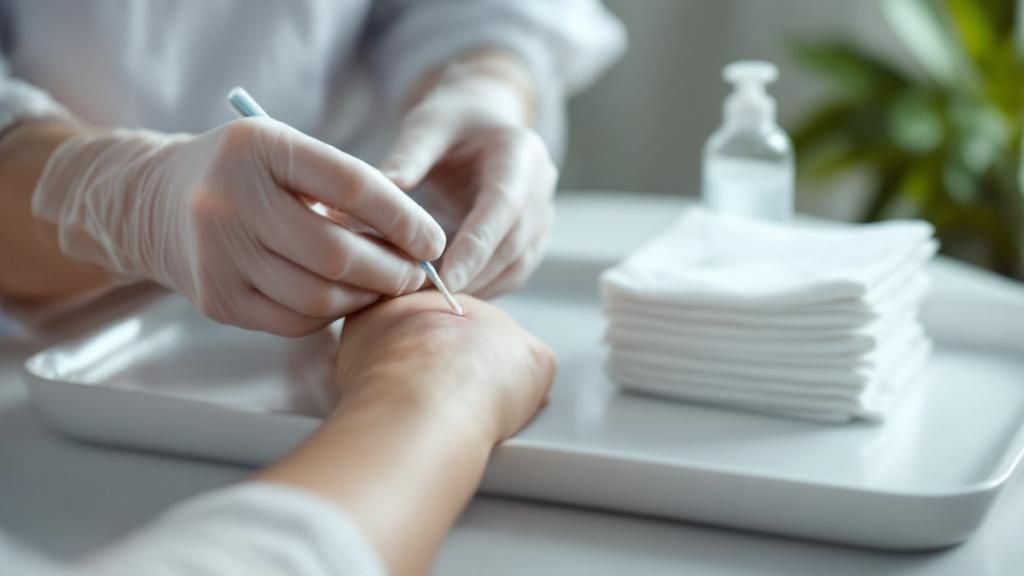Understanding Why Preventing Wound Infections Changes Everything
Preventing wound infections isn't simply about avoiding discomfort. It's about protecting your overall health and well-being. A minor infection can rapidly become serious, leading to complications that affect every aspect of your life. This makes proactive infection prevention essential for a smooth and timely recovery. You might be interested in learning more about the different types of wounds.
The Real Cost of Wound Infections
The consequences of a wound infection go beyond the immediate physical symptoms. These infections can cause extended hospital stays, increased medical bills, and time away from work or other activities. They can also significantly diminish your quality of life, making it harder to perform daily routines and enjoy social interactions. In some situations, chronic infections can even result in long-term health issues or disabilities.
Debunking Common Myths and Embracing Evidence-Based Practices
Many misunderstandings exist around wound care, and these myths can unintentionally increase the risk of infection. For example, some believe wounds should be left open to "air out." However, this exposes the wound to harmful bacteria. Another common misconception is that hydrogen peroxide is the best cleaning solution. In reality, it can damage healthy tissue and hinder healing. Evidence-based practices, such as proper hand hygiene, using appropriate wound dressings, and keeping the wound clean and moist, are vital for preventing infections.
The World Health Organization (WHO) emphasizes the importance of infection prevention and control (IPC) in preventing wound infections, especially in healthcare settings. Healthcare-associated infections (HAIs), including surgical site infections, are a major cause of prolonged hospital stays, increased illness, and even death worldwide. Following standardized IPC protocols, including hand hygiene, sterilizing medical equipment, and proper wound dressing changes, has significantly reduced the occurrence of wound infections. Explore this topic further here.
Why Every Prevention Step Matters
By understanding the real impact of wound infections and adopting evidence-based prevention strategies, you invest in your health and future. Each step you take to prevent infection, no matter how small, contributes to a faster, more comfortable, and more complete recovery. This proactive approach not only minimizes potential problems but also allows you to take control of your healing process.
Mastering Immediate Wound Care for Infection Prevention
When you experience a wound, your initial actions significantly impact the healing process. Taking the right steps can lead to a quick recovery, while improper care can increase the risk of infection. Understanding how to assess and clean wounds, choose appropriate cleaning solutions, and recognize when professional medical attention is necessary is crucial for effective wound management. You might be interested in: How to heal deep wounds faster.
Initial Assessment and Cleaning
The first step in preventing wound infections involves a thorough assessment. This includes determining the type of wound, its depth, and the extent of the damage. For instance, a puncture wound requires different care than a graze or a surgical incision. After assessing the wound, proper cleaning is essential.
This involves gently removing any debris or foreign objects to create a clean environment conducive to healing. Even small particles can introduce bacteria and hinder the body's natural healing mechanisms.

As the infographic shows, clean hands, running water, and mild soap are fundamental for effective wound cleaning. This simple process establishes a foundation for healthy healing and minimizes infection risk.
Choosing the Right Cleaning Solution
Many people mistakenly use hydrogen peroxide to clean wounds, but it can damage healthy tissue and impede healing. Mild soap and water or a saline solution are the preferred choices. These options effectively cleanse the wound without harming healthy tissue.
Avoid using harsh chemicals or antiseptic solutions unless directed by a healthcare professional. These can disrupt the delicate balance of the wound environment and delay healing. The goal is to promote a clean and healthy environment for the body's natural healing processes to take over.
Knowing When Home Care Isn't Enough
While many minor wounds can be effectively managed at home, some situations require professional medical attention. Deep wounds, animal bites, or wounds showing signs of infection, such as increased pain, redness, swelling, or pus, warrant a visit to a doctor or urgent care clinic.
Prompt medical evaluation ensures appropriate treatment and minimizes the risk of complications. Delaying professional care can lead to more serious issues, so recognizing when home care is insufficient is crucial for effective wound management.
The following table provides a quick guide for proper immediate wound care.
Immediate Wound Care Action Steps:
This table compares proper and improper immediate wound care techniques step-by-step.
| Action Step | Correct Technique | Common Mistakes | Infection Risk |
|---|---|---|---|
| Cleaning | Gently wash with mild soap and water or saline solution. Rinse thoroughly. | Using hydrogen peroxide, harsh chemicals, or scrubbing vigorously. | High with improper cleaning. |
| Dressing | Apply a clean bandage to protect the wound. | Leaving the wound uncovered or using dirty materials. | Significantly increased if left uncovered or improperly dressed. |
| Monitoring | Watch for signs of infection (redness, swelling, pus, increased pain). | Ignoring changes in the wound or delaying medical attention. | High if warning signs are ignored. |
This table highlights the importance of following the correct procedures for wound care to minimize the risk of infection. Early intervention and proper technique are essential for a smooth and healthy healing process.
Cutting-Edge Technologies Revolutionizing Wound Protection
Modern wound care has come a long way from basic bandages and antiseptic solutions. Effective infection prevention is critical for proper healing and minimizing complications. Exploring new technologies can be a real difference-maker, especially for chronic wounds or those that pose healing challenges.
Advanced Antimicrobial Dressings: A Shield Against Infection
A key innovation is the development of antimicrobial dressings. These dressings are infused with agents that actively fight bacterial growth, unlike standard bandages. This creates a hostile environment for pathogens, significantly reducing infection risk. Silver-impregnated dressings, for example, have shown excellent results against a broad spectrum of bacteria, promoting faster healing and minimizing scarring.
Some advanced dressings release antibiotics or other antimicrobial agents directly onto the wound, providing targeted treatment and further enhancing infection prevention.
Negative Pressure Wound Therapy: Accelerating Healing and Reducing Infections
Negative pressure wound therapy (NPWT) represents another significant advance in wound care. This technology uses a specialized dressing and vacuum pump to apply controlled negative pressure to the wound bed. NPWT removes excess fluid and infectious materials, stimulates blood flow, and helps healthy granulation tissue form. This accelerates healing and significantly lowers the risk of infection, making it particularly helpful for complex or chronic wounds.

The Growing Importance of Advanced Wound Care
The increasing occurrence of chronic wounds, like diabetic foot ulcers, is driving demand for advanced wound care technologies. These ulcers affect 15-25% of people with long-term diabetes worldwide and carry a high risk of infection. The global advanced wound care market, valued at approximately USD 11.82 billion in 2025, is expected to reach USD 18.04 billion by 2034.
This growth is fueled by the need for effective infection prevention and advanced treatment methods. Find more detailed statistics here. These technologies offer new hope for patients with challenging wounds, showcasing the continual progress of wound care toward safer and more effective healing solutions.
Building Daily Routines That Actually Prevent Infections
Preventing wound infections isn't just about initial care; it's about consistent daily attention. This means establishing routines that fit into your life while effectively preventing infection. Building sustainable habits ensures you maintain necessary care without feeling overwhelmed. Learn more in our article about effective post-discharge wound care at home.
Creating a Sustainable Care Schedule
Developing a realistic schedule is the first step toward consistent wound care. Consider your work, family, and lifestyle. Maybe morning and evening routines work best, or perhaps lunchtime is more convenient. The key is creating a sustainable schedule.
Consistency is vital. Each dressing change and cleaning reduces bacteria growth. Think of it like brushing your teeth: a small daily commitment for long-term health.
Managing Different Wound Types
Different wounds need different approaches. A small cut may need cleaning and a bandage change once a day. A larger, more complex wound might require more frequent attention and special dressings. Understanding your wound type is crucial.
For example, a burn might need regular ointment and non-stick dressings. A surgical wound may require monitoring for dehiscence and specific cleaning. This tailored approach prevents complications and optimizes healing.
Troubleshooting Common Problems
Even with the best routines, challenges happen. Maybe your wound hurts during dressing changes, or you're struggling to keep it dry. Addressing these problems promptly keeps you on track.
Switching to a non-adherent dressing can minimize pain. If moisture is a problem, absorbent dressings can help. Adaptability is essential.
Adapting as Healing Progresses
As your wound heals, your routine should evolve. Initially, frequent cleaning and dressing changes are important. As the wound closes and new tissue forms, you can gradually reduce care frequency.
This prevents over-drying and allows new skin to strengthen. Regularly assessing your wound and consulting with a healthcare professional ensures appropriate care throughout each phase. This flexibility is fundamental.
Maintaining Motivation
Chronic wounds can require extensive, long-term care. Maintaining motivation can be challenging. Remember, consistent care is an investment in your health and well-being.
Celebrate small victories, like reduced pain or improved appearance, to stay motivated. Focus on the end goal – a healed wound and a return to normal activities. This ensures long-term success in preventing wound infections.
Spotting Infection Warning Signs Before It's Too Late
Knowing when a wound requires professional medical care can prevent serious complications. This involves recognizing the initial, and often subtle, signs of a developing infection. These signs can vary from small changes in the wound's appearance to more widespread symptoms, indicating a spreading infection. Understanding these warning signs allows you to act quickly and stop a minor problem from becoming a serious health issue.
Recognizing Local Infection Signs
The first indications of a wound infection often appear at the wound site. Increased redness and swelling beyond the initial injury are important indicators. Some redness and swelling are a normal part of healing, but excessive or expanding inflammation suggests a possible infection. Also, increasing pain, especially throbbing or radiating pain, needs attention. A wound shouldn't become more painful as it heals.
Another clear sign is the presence of pus or unusual discharge. This discharge might be yellow, green, or cloudy, and often has an unpleasant odor. Any such drainage, particularly if combined with increasing pain or redness, indicates a potential infection. Closely observing your wound is critical for early detection. You might be interested in: How to master wet-to-dry wound care dressing changes.
Identifying Systemic Infection Symptoms
Sometimes, infection signs go beyond the wound itself, suggesting the infection is spreading. A fever, especially with chills, suggests your body is fighting an infection. Nausea and vomiting can also occur, particularly with more severe infections. These systemic symptoms demand immediate medical care.
From Normal Healing to Concerning Developments
It's important to distinguish between normal healing and signs of infection. Some swelling and redness are typical right after an injury. However, these should gradually lessen as the wound heals. A scab forming over a wound is a positive sign of healing. But, if the scab is accompanied by increased redness, swelling, or pus, it might indicate an infection.

Recognizing the visual difference between a healing wound and an infected one is essential to avoid complications.
The following table highlights key warning signs and what they indicate:
Infection Warning Signs Assessment
Visual and symptom indicators that require immediate medical attention
| Warning Sign | Severity Level | Timeframe for Action | What It Indicates |
|---|---|---|---|
| Increased redness and swelling beyond initial injury | Moderate to Severe | Monitor closely, seek medical advice if it worsens or spreads | Possible infection |
| Throbbing or radiating pain | Moderate to Severe | Seek medical advice promptly | Potential infection |
| Pus or unusual discharge (yellow, green, cloudy, foul odor) | Moderate to Severe | Seek medical advice immediately | Likely infection |
| Fever, especially with chills | Severe | Seek immediate medical attention | Body fighting infection |
| Nausea and vomiting | Severe | Seek immediate medical attention | Potential severe infection |
This table summarizes the visual and symptomatic indicators of a potential wound infection, ranging from localized issues like redness and pus to systemic symptoms like fever and nausea. Prompt action based on these signs is crucial.
Taking Swift Action: When Home Care Becomes Harmful
While minor wounds can often be cared for at home, knowing when to seek professional help is critical. Any signs of infection, especially systemic symptoms like fever or chills, warrant immediate medical attention. Delaying treatment allows the infection to worsen, potentially causing serious health problems.
Effective Communication with Healthcare Providers
Clear communication with your healthcare provider is key to receiving appropriate care. Be precise about your concerns. Describe any changes in the wound, including when symptoms started and how they've progressed. Don't hesitate to ask questions. Open communication ensures prompt and appropriate treatment.
Specialized Strategies for High-Risk Healing Challenges
Some people face significant hurdles in preventing wound infections. This is often due to underlying health issues or other contributing factors. These challenges require specialized strategies to promote effective healing. This involves tailoring standard prevention methods to meet individual medical needs and circumstances.
The Impact of Underlying Health Conditions
Conditions like diabetes, compromised immune systems, and circulation problems can greatly affect wound healing. They also increase a person's vulnerability to infection. For instance, diabetes can impair blood flow and nerve function. This makes it difficult for the body to fight infection and heal properly. A weakened immune system struggles to fight off bacteria, raising the risk of serious complications. Learn more about our approach to treating diabetic foot ulcers.
Likewise, poor circulation can slow the delivery of oxygen and nutrients vital for tissue repair. This makes wounds more susceptible to infection and slows the healing process considerably. It's crucial to address these underlying conditions to support optimal wound healing.
Addressing Contributing Factors
Beyond specific diseases, factors like age, nutrition, stress, and chronic illnesses also influence wound healing. Older adults often experience slower healing rates. Poor nutrition can deprive the body of the building blocks needed for tissue repair.
High stress can suppress the immune system. This hinders the body’s ability to fight infection. These diverse factors highlight the importance of a holistic approach to wound care. It emphasizes considering the whole person, not just the wound itself.
Adapting Standard Prevention Practices
Standard wound care practices are important but often need adjustments for high-risk individuals. For example, those with diabetes may benefit from specialized dressings that improve circulation and maintain moisture balance. People with compromised immune systems need meticulous hygiene and careful monitoring for signs of infection.
Tailoring wound care to each person's unique needs is paramount for positive outcomes. This individualized approach ensures the most effective treatment plan is in place.
Working with Specialized Healthcare Teams
Collaborating with a specialized healthcare team is often crucial for individuals with high-risk healing challenges. This team might include wound care specialists, nurses, dietitians, and other healthcare professionals. They offer expert guidance, monitor healing progress, and adjust treatment as needed.
This collaborative approach ensures personalized care, addressing individual risk factors and promoting optimal healing. It also allows for quick intervention if complications arise, minimizing the risk of serious infection. This integrated approach is key to achieving the best possible results for those facing these unique circumstances. It empowers patients to actively participate in their recovery.
Key Takeaways
Preventing wound infections is crucial for a healthy recovery. By understanding the basics of wound care and using practical strategies, you can significantly lower your risk and encourage efficient healing. This section offers actionable takeaways to guide you through every stage, from initial care to long-term maintenance.
Immediate Action: The First Line of Defense
The first steps you take after an injury are vital for infection prevention. Keep these key actions in mind:
-
Cleanse Thoroughly: Gently wash the wound with mild soap and water or a saline solution. Avoid strong antiseptics like hydrogen peroxide, which can harm healthy tissue.
-
Dress Appropriately: Apply a clean, sterile dressing to shield the wound from contaminants. The dressing type can vary based on the wound, so consult a healthcare professional for guidance.
-
Seek Professional Help When Needed: Deep wounds, animal bites, or wounds with signs of infection need immediate medical attention. Don't hesitate to seek help if you are uncertain about the severity.
These immediate actions establish a base for healthy healing and minimize the risk of bacteria entering the wound.
Daily Habits for Consistent Protection
Consistent daily care is as important as initial action. These practices help prevent infection and promote healing:
-
Establish a Routine: Create a regular schedule for cleaning and dressing changes. This consistency helps keep bacteria at bay.
-
Adapt Your Approach: Different wounds require different care. Understand your specific wound type and adjust your routine accordingly. For example, burns might need specialized ointments and dressings.
-
Address Challenges Proactively: Issues like pain or excessive moisture can hinder healing and increase infection risk. Use appropriate solutions like non-adherent or absorbent dressings.
These daily habits maintain a clean wound environment and support your body's natural healing.
Recognizing Warning Signs and Taking Action
Recognizing the signs of a wound infection is crucial for preventing serious problems. Watch for these indicators:
-
Local Signs: Increased redness, swelling, pain, and pus or unusual discharge from the wound.
-
Systemic Signs: Fever, chills, nausea, and vomiting, which indicate a potentially spreading infection.
If you observe any of these warning signs, seek medical attention right away. Early intervention can prevent a minor infection from becoming a serious health problem.
Specialized Care for High-Risk Situations
Individuals with certain conditions, like diabetes or weakened immune systems, have a greater risk of wound infections. These situations require specific approaches:
-
Address Underlying Conditions: Managing existing health issues is crucial for healthy wound healing.
-
Adapt Standard Practices: Adjust cleaning and dressing routines to individual needs. Specialized dressings can be beneficial.
-
Collaborate with Healthcare Professionals: Work closely with a healthcare team, including wound care specialists, to create a personalized treatment plan.
These specialized strategies offer targeted care for individuals at higher risk of infection, optimizing their healing.
Long-Term Strategies for Sustainable Wound Health
Preventing wound infections is an ongoing process, continuing beyond the initial healing phase. Here are some long-term strategies:
-
Maintain Good Hygiene: Practice proper handwashing, particularly before and after wound care.
-
Support Your Immune System: A healthy diet, regular exercise, and managing stress contribute to a strong immune system, crucial for preventing infections.
-
Be Proactive: If you have a chronic wound, maintain regular communication with your healthcare provider and follow recommended care guidelines.
These strategies create a foundation for long-term wound health and reduce your risk of future infections. To learn more about personalized wound care, visit Rapid Wound Care. Their team specializes in comprehensive at-home wound care, helping patients achieve optimal healing.

